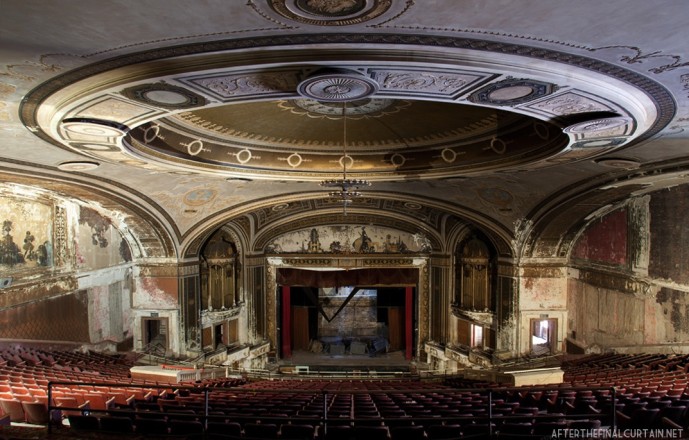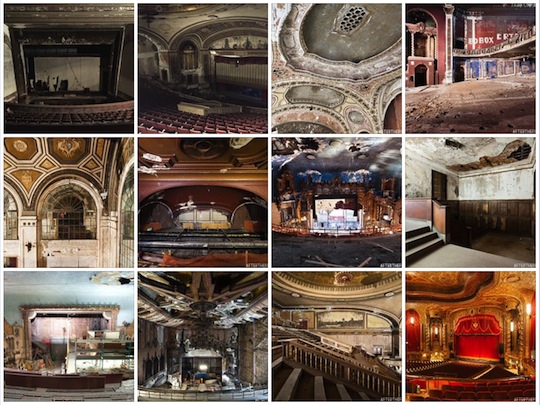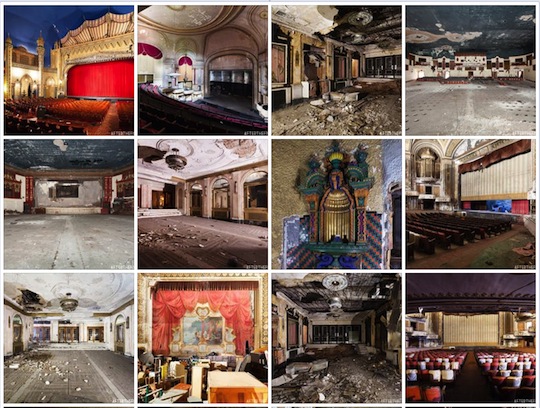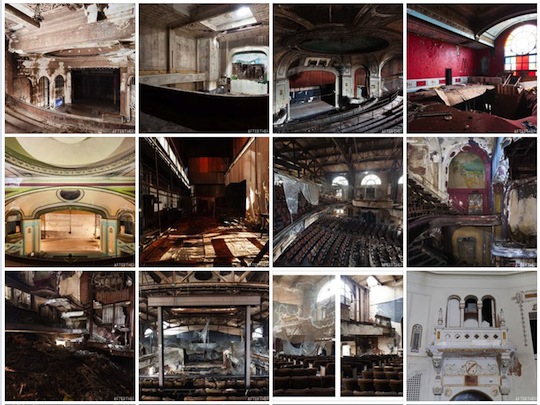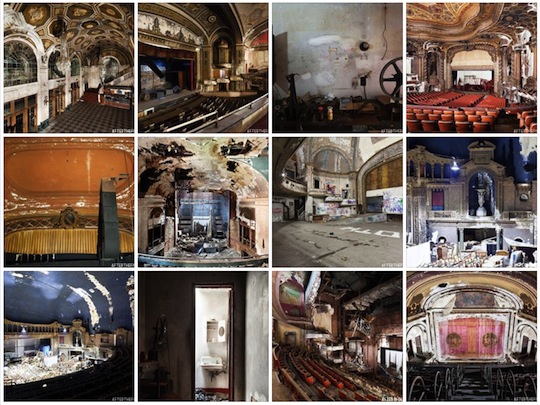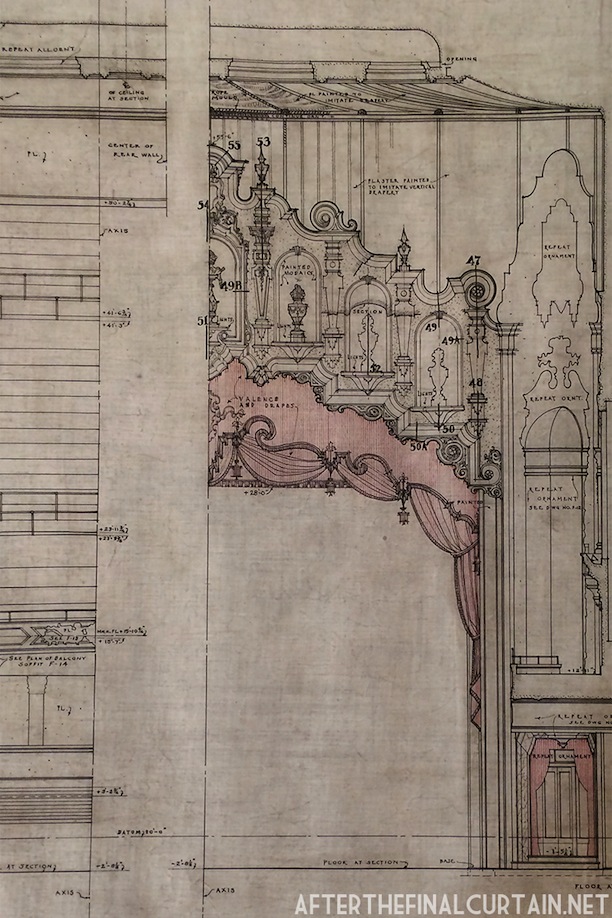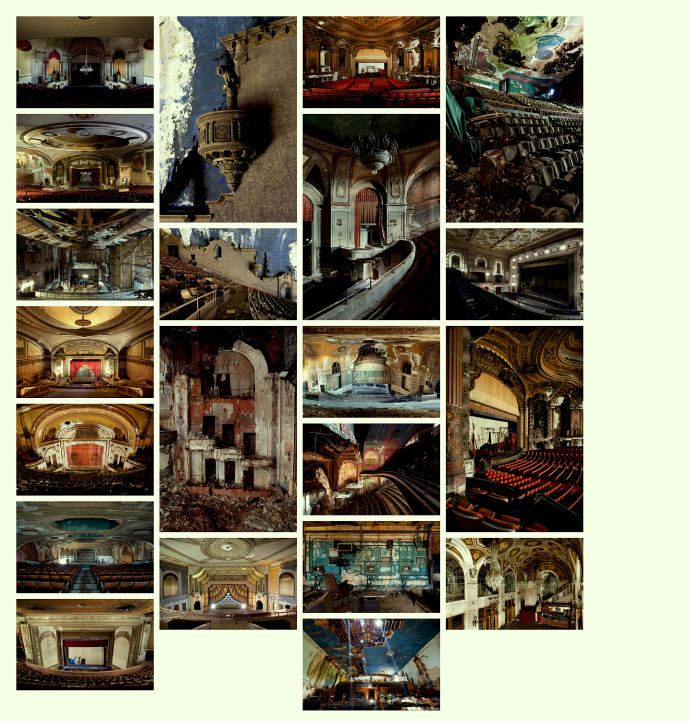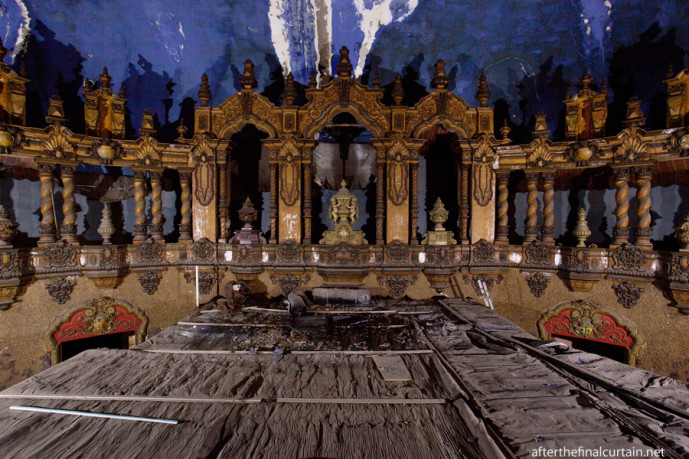Click here to print
Crumbling Movie Houses that Were Main Attractions
posted July 17, 2015
With his riveting images, a photographer seeks to preserve the magic, if not the bricks and mortar, of the shuttered cinema palaces of America.
b
By Peter Monaghan All images by Matt Lambros, from After the Final Curtain
n
d
For Matt Lambros, a photographer based in Brooklyn, New York, grand movie palaces of the United States hold such fascination that he has spent six years documenting them, and counting – his fascinating spin on the history of the giant cultural hubs is to show what has become of the many that have fallen into disuse and dilapidation.
n
The title of his extensive project of capturing the beauty of the neglected, decaying, and decrepit hulks is After The Final Curtain. He describes the work he displays and sells on its website as “photographic obituaries” for crumbling and forgotten buildings that once buzzed with social activity. He writes on the website: “My hope for my work is that it will shine light on beautiful, dated architecture and on the equal yet sinister beauty in decay.”
But, as Lambros says by phone from Brooklyn, New York, he wants more than to have his project’s many admirers revel in the haunting presence of the tattering structures. By recording the grand wrecks, with their vast, elaborately built spaces, ornately decked with finely crafted balconies, seating, chandeliers, porticoes, and balustrades, he hopes to evoke and even revive their glories. He says he wants to provoke viewers and reader to exclaim “there’s an old building that was left to rot, but here is what it could become.”
That may well be readers’ response to his book, due out soon, presenting his photographs of a remarkable theater in a state of decay, but also detailing its planning, construction, and soul, as well as images of its gradual renovation over the last four years. Kings Theatre, The Rise, Fall and Rebirth of Brooklyn’s Wonder Theatre , which will likely appear towards the end of 2015, will cover the entire history of the Loew’s Kings Theatre on Brooklyn’s Flatbush Avenue, from its opening in 1929 to its closure in 1977 to its and recent reopening [in March 2015] as a performing-arts center after extensive repair.
n
The THS Press of the Theatre Historical Society of America is publishing the book, in an acknowledgement of the importance of work as inspiring and thorough as Lambros’s. His project resonates with the work of mission, which since the mid-1950s has collected photographs, renderings, artifacts, furnishings, and other artifacts from more than 16,000 theaters across America and elsewhere. Its archives include more than 2,000 images from Loew’s theaters; 1,400 photos of about 300 iconic Chicago theaters; and corporate records of the Balaban & Katz theater chain that dominated the Chicago market in the 1930s.
“If people don’t read a word of the text, they’ll be able to see what the Kings was like when it opened, and what happened to it, and what it took to bring it back,” says Lambros. He refers to the structure, one of his earliest movie-house loves, as “a gorgeous red velvet palace.” For his book, he had access to the whole restoration process, with its repairs to the seats, carpeting, tapestries, curtains, light fixtures, and much else.
The Loew’s Kings is just one of 76 abandoned, shambolic theaters Lambros has documented over the past six years. His project’s website offers stunning galleries of their strange beauty.
To call the cinema palaces “cathedrals” would not overstate the grandeur, bravura, grace, and worship that gloried within them, and in many cases now echoes in their mausoleums. Projects as accomplished as Lambros’s unsurprisingly provoke awed excitement within movie-goer ranks, as well as those of architectural and urban historians. What Lambros’s project shares with some other outstanding online resources that have emerged from that fascination is his ability to capture how powerfully the buildings, in their death throes, summon an earlier mode of shared, larger-than-life social and cultural engagement. Other expressions of that devotion have included the extraordinary Cinema Treasures (see MIAN article from 2010); Mary Hanlon’s Some Enchanted Evenings: American Picture Palaces; Stefanie Klavan’s color-saturated portraits on her site, America’s Vanishing Movie Palaces & Drive-In Theaters; and the Southeast Asian Movie Theater Project. There’s also the outstanding work of Matthew Christopher, of which more, below.
thank his grandmother
Lambros was infected with a fascination for run-down buildings in early childhood. He recalls that his grandmother would take him and his little brother to old barns to see what mysteries and magic they might possess: “She was curious about what was left behind, and her inquisitive nature made a lasting impression on me.”
That was in Dutchess County, New York, where he grew up. The region around Beekman, outside Poughkeepsie, had its “haunted” buildings, as many regions do, and his grandmother had primed him to see them as “begging for a closer look.”
He says: “We’d be driving somewhere and she’d say, ‘Oh, look at that!’
“But then she had to stop for a little while, because it came up in my parents’ divorce.” During the proceedings, it came to legal notice that the barn-snooping had been going on even when Lambros was four and his brother only one year old. Lambros cheerfully recalls that his grandmother wasn’t slowed for long by the marriage-court rebuke: “Even after that she liked to go on hikes and find old houses or foundations of houses.
“But her father did the same stuff. He used to explore caves on his property in Missouri.”
While Matt Lambros has been photographing abandoned theaters for six years, he started out, 12 years ago, photographing abandoned psychiatric asylums and prisons. He explored one, the Hudson River State Hospital, both on his own and then with friends. They stalked the hospital precinct late at night, scaring each other.
“But doing research about the history of those places is terribly, terribly depressing,” he says. His switch to theaters came after he had taken a year off: “I was in a theater in New York City watching a really bad movie and was looking at the architecture of it. It wasn’t a movie palace, but it was an old neighborhood theater, and I thought, ‘there’s gotta be some abandoned theaters, somewhere.’ I had been to a couple when I was shooting old abandoned buildings, but they were always the theater part of an asylum, or in one case it was a seminary school and had a really cool theater.”
It reminded him that he often found theaters to be the most redeeming spaces in the asylums he’d visited, and of similarly admiring a theater in an abandoned seminary school.
Loew’s Kings in Brooklyn became his first great love in derelict grand movie houses, but he has traveled the US coast to coast, now, sometimes at the invitation of groups intent on reviving old houses as performing arts centers. Knowing where to look for likely subjects has become a matter of both research and a sense of what may lie, taken for granted, behind facades on city streets. Once he has posted his galleries, viewers commonly exclaim that they walk by the building every day yet had no idea that theater was within.
He has developed a nose for the hidden gems. He recalls, for instance, sitting in a restaurant eating dinner, looking across the street at a bodega, and being alerted by a fire escape. “I looked at the shape of a building, and I thought, ‘That’s a theater! What theater was that?’”
When he began shooting old theaters, gaining access could be difficult — at least, when it wasn’t just a matter of walking through the openings that let the weather into many of the edifices — but he is now well enough known, and has so impressive a portfolio, that that is now rarely a problem. More generally, he says, “I’m very persistent; I make a lot of phone calls; that’s how I get in.”
He clearly also has learned to master the difficult lighting conditions he encounters in the buildings. He illuminates theater interiors as well as he can with simple equipment, and then relies on camera exposures of up to many minutes.
the lives they’ve led
The theaters whose mortality Lambros is immortalizing have had storied lives. Many began as movie houses, but some are old enough to have presented vaudeville acts before the golden age of film. Many remained open long enough to see the tumult of rock and roll. But for Lambros as for so many movie-goers today, these curious histories were not something that really occurred to him, during his childhood and youth. “Going into this, I had no idea,” he says. “I was born in the early ’80s, and grew up going to multiplexes; that’s where you saw a movie. Any theater like the Kings was one you’d go see a play, at a performing-arts center, because that’s what a lot had turned into.”
Once he started researching the theaters, “it led me down a rabbit hole, and I’ve been climbing through it ever since,” he says. Down that warren, he discovered an era that was startling in the scope of its film culture. He was struck, for example, by such aspects of theater construction as the availability of ready-made plaster panels from vendors like Jacobson & Company. That New York-area firm, still in operation, provided plaster ornamentation for some of the most renowned buildings of the era including The Cloisters in northern Manhattan; the Presidential Palace in Havana, Cuba; the Hearst Residence in San Simeon; and many theaters around the world. Gustave Jacobson formed the business in 1889 from his parents’ simple picture-framing concern. At first just a plastering contractor, the Jacobson company quickly grew to employ 80 artisans making decorative paneling.
Huge theaters of 3,000 or more seats, with ushers and other liveried staff to create a sense of occasion, had draw that continually astonishes Lambros: “They used to sell out!” he exclaims. “You wouldn’t go and just see one movie. There’d be a vaudeville show, and there’d be an orchestra performing music, there’d be a little comedy act, and a newsreel, and cartoons, as well as the main feature. So you’d be there for five hours. It was more like going to a live Broadway play than going to a movie, now.”
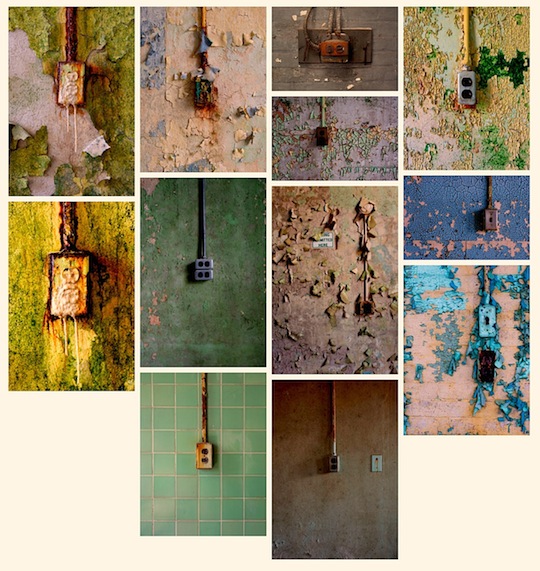
For Lambros, even power outlets, light switches, and the like have their charm, once well on their way to inutility.
n
The financial challenges of running any theater are considerable, and those of maintaining movie palaces enormous. Lambros believes, however, that the lesson of Loew’s Kings, the house featured in his forthcoming book, is that renovation can work, either because a reborn theater offers the prospect of reviving an urban space, or because in cities that achieve economic resuscitation, planners come to realize that theater renovations can clinch the comeback.
While shuttered, the Loew’s Kings was, to say the least, pregnant with potential. The firm of Rapp & Rapp designed the huge auditorium of 3,600 seats to be one of the five “Wonder Theaters” of the Loew’s chain, and as one of the first theaters primarily for film. Long on the National Register of Historic Places, its renovation was not cheap, running to $93-million, but already, Lambros says, new construction is already occurring, in the streets around it. “Some other theaters are in great shape, and it wouldn’t take that much to restore them,” he says.
Others, not so much. In gutted urban landscapes, abandoned institutions quickly become magnets of curious thrill seekers, as much as of historically minded aesthetes, and in that regard their dangers make them, in legal terms, attractive nuisances. “With some, it’s real dangerous,” Lambros says. “I’ve had to sign waivers, and to have the waivers notarized.” He ensures his photographer’s insurance is always paid up, to cover himself and an assistant. His closest brush with injury was fortunately only close: in the Palace Theater in Gary, Indiana, a Rust Belt city rife with infrastructure decay, he wisely heeded the warning of a spray of falling dust that preceded the crashing to ground right next to him of a sizable chunk of ceiling plaster. “That’s the one time I can think of where it was really sketchy,” he says.
Some theaters have suffered considerable vandalism and also “scrapping” – the practice of scavenging salable building materials from abandoned or unguarded structures. One such is the Eastown Theatre,in Detroit, which he photographed in 2012.
Fabled from the 1930s for its Renaissance Revival architecture, with Spanish and Italian Baroque and Neo-Classic elements, it was a jewel on the Wisper-Wetsman Theaters circuit. It later gained prominence in rock history, but stuttered through city officials’ efforts to shut it down in the early 1970s due to its reputation as a venue for drug dealing. It struggled on in various guises including as a raunchy-movie cinema from 1980 to 1984, and then as a magnet for unauthorized raves and presumably divinely sanctioned gatherings of an evangelical church. A 2010 fire seemed a final insult, but more affront was yet in store, says Lambros: “Scrappers came [in 2014] and stole the roof.” They scrapped the steel beams holding it up, so it collapsed, which scuppered the balcony, and now it’s an amphitheater: three walls and a proscenium.” It’s a is fate suffered by institutional shells all around Detroit, and other cities, too.
If moldering theaters are correlates of evolving entertainment practices, and if cities like Detroit are rust-belt industrial America’s demise writ large, the neglect and abuse of grand buildings is just plain crying shame. Urban frustration and desperation are such that it’s perhaps unfair to brand as criminal or immoral the looting of whatever can be profitably salvaged from the palaces of fallen powers. Their steel, alone, is worth the risks, of which prosecution seems not to be the greatest. Yet, the predation’s results echo those of ivory poachers in Africa.
In the case of the Eastown, its vultures sometimes certainly appear more gluttonous than hungry, as in such incidents as the calculated and complicated removal of decorative elements from the theater’s roof. Who, asks William Shakespeare, has the four faces of Comedy?
The Eastown won’t be saved, now.
more theaters, more books
For other structures, hope remains. Last December (2014), Lambros posted on his site a series of his images from Loew’s Canal Theatre which opened in 1927 in lower Manhattan. The Loew’s Corporation hired the eminent Scottish-born American theater architect, Thomas W. Lamb, for the 2,314 seat theater, then the city’s second-largest motion-picture theater. Its fate from there has been mixed. A year after it opened, Loew’s sold it to the Greater M&S Circuit, but then quickly bought it back when the new owner went bankrupt. In 1932, it suffered an explosion that blew up its ticket booth, apparently a signal of dissatisfaction from striking motion-picture operators. It closed in the late 1950s, and its auditorium served as a warehouse and its lobby became retail space that was used until a few years ago.
In 2010 the city’s Landmarks Preservation Committee designated its terracotta façade a New York City Landmark, and a plan of the city’s Committee to Revitalize and Enrich the Arts and Tomorrow’s Economy to help the owners convert the building into a performing-arts center came to nothing. The owners have tried to convert the space into an 11-story condominium complex, but the City so far has rejected the plan, and its auditorium remains a warehouse, and its lobby a void.
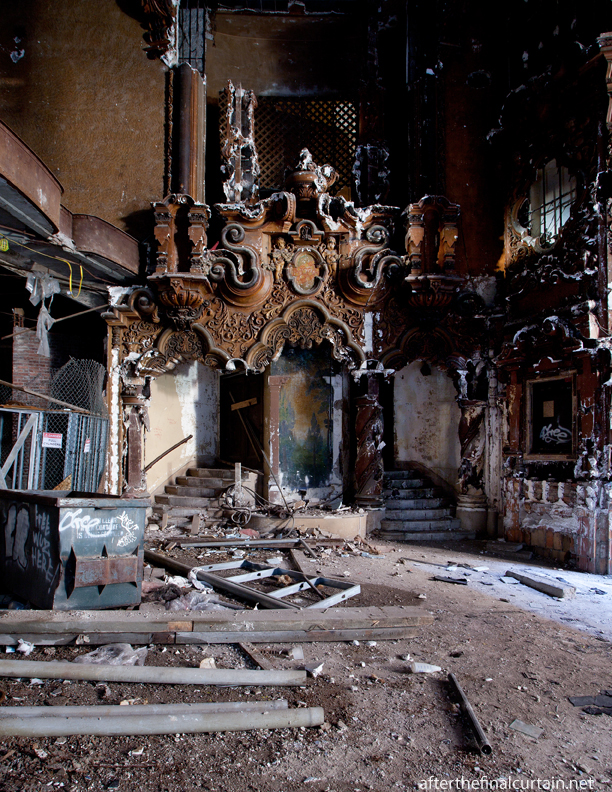
One particularly sorry shell is that RKO Keith’s Theater in Flushing, Queens, which is scheduled to be transformed into a multi-use complex of apartments, shops, parking, and a senior center, with only its lobby retained as a theater edifice. The building exemplifies how damaged – and treacherous – abandoned theaters can be. Water has brought down its ceilings and caused extensive other damage.
Lambros says he expects he’ll go on to write books on other theaters and their histories, both in the eastern US, and the West. “I wouldn’t be able to fit them all in one book,” says the graduate of Boston University’s digital imaging and photojournalism program whose day job is as a staff photographer at a medical publishing company. Meanwhile, he sells prints from his website, and offers workshops on how to do what he does, sometimes in collaboration with a fellow photographer, Matthew Christopher, whose own project is Abandoned America. “We’ve done three this year, and we’re trying to do one or two more sometime this fall,” Lambros says.
For a recent event, he and Christopher took a group of photographers to the Victory Theater in Holyoke, Massachusetts. The 1,680-seat hall, built by the Boston firm, Mowll & Rand, opened in 1920, its name a salute to the Allied forces’ prevailing in World War I. It presented both films and vaudeville until the decline of the live-theater format in the early 1930s. It closed at the end of 1978, and was seized by the city of Holyoke, for tax delinquency. Ownership transferred in 2008 to the Massachusetts International Festival of the Arts, which plans to renovate it as a performing-arts center.
Unsurprisingly, clambering through huge dilapidated theaters is not the safest of activities, as Lambros and Christopher are at pains to impress upon enrollees in their workshops. They caution: “You need to be very aware of your safety.” Each workshop has a site manager whose word must be heeded on pain of dismissal from the site. Participants also sign a waiver to acknowledge that they accept risks, which may include the presence of mold and dust. “Respirators are highly recommended,” the Victory Theater prospectus exclaimed.
They guarantee to show aspiring abandoned-building photographers how to deal with the difficult lighting of the structures, so that imaginative photographers can breathe life not only into their portfolios, but also the lives of grand old urban spaces. For, the irony of Lambros’s project, After the Final Curtain, is that it gives the lie to its name,: It raises a tattered curtain on shuttered entertainment venues, and allows them to gesture through decrepitude a sort of overripe beauty. The emblem of his site, while it could be “All right, Mr. Lambros, I’m ready for my close-up,” is instead an observation of the great movie-house entrepreneur, Marcus Loew: “People buy tickets to theaters, not movies.”
n
n
Headline image: The Loew’s Palace Theatre opened in 1922 in Bridgeport, Connecticut. Matt Lambros features other buildings by its architect, Thomas W. Lamb, in his pages of images of the Newark Paramount Theatre and the RKO Keith’s Theatre. The 3,642 seat Bridgeport palace, originally called Loew’s Poli Theatre, was the largest movie theater in the state of Connecticut.
n
n
Printed from Moving Image Archive News: https://www.movingimagearchivenews.org
URL to article: https://www.movingimagearchivenews.org/crumbling-movie-houses-that-were-main-attractions/
Click here to print
